engine PORSCHE CAYNNE 2010 1.G Service Manual
[x] Cancel search | Manufacturer: PORSCHE, Model Year: 2010, Model line: CAYENNE, Model: PORSCHE CAYENNE 2010 1.GPages: 379, PDF Size: 13.91 MB
Page 153 of 379
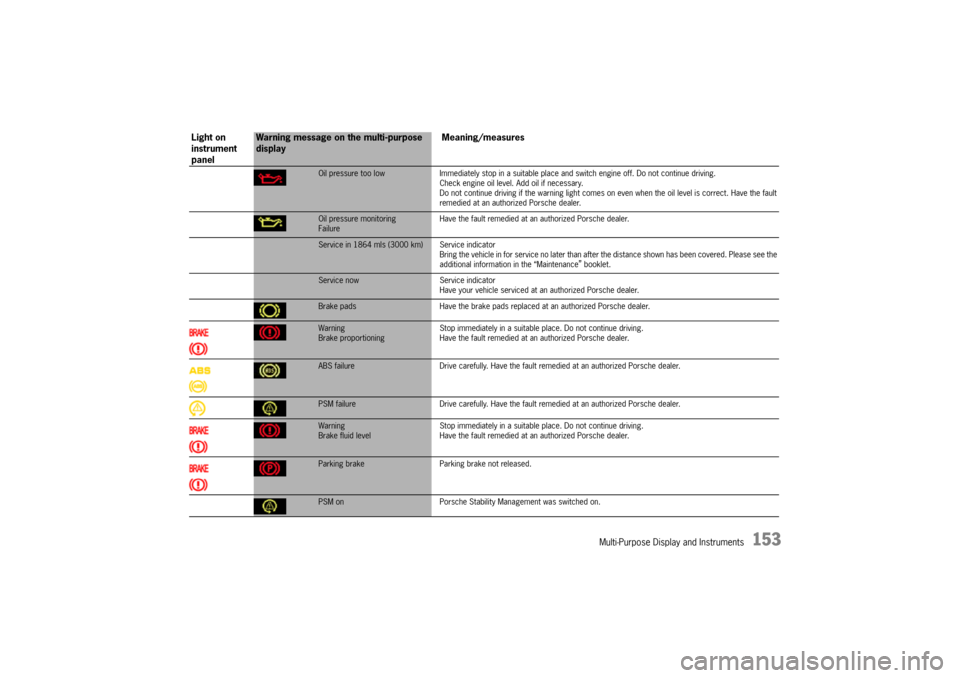
Multi-Purpose Display and Instruments
153
Oil pressure too low Immediately stop in a suitable place and switch engine off. Do not continue driving.
Check engine oil level. Add oil if necessary.
Do not continue driving if the warning light comes on even when the oil level is correct. Have the fault
remedied at an authorized Porsche dealer.Oil pressure monitoring
FailureHave the fault remedied at an authorized Porsche dealer.Service in 1864 mls (3000 km) Service indicator
Bring the vehicle in for service no later than after the distance shown has been covered. Please see the
additional information in the “Maintenance
” booklet.
Service now Service indicator
Have your vehicle serviced at an authorized Porsche dealer.Brake pads Have the brake pads replaced at an authorized Porsche dealer.Warning
Brake proportioningStop immediately in a suitable place. Do not continue driving.
Have the fault remedied at an authorized Porsche dealer.ABS failure Drive carefully. Have the fault remedied at an authorized Porsche dealer.PSM failure Drive carefully. Have the fault remedied at an authorized Porsche dealer.Warning
Brake fluid levelStop immediately in a suitable place. Do not continue driving.
Have the fault remedied at an authorized Porsche dealer.Parking brake Parking brake not released.PSM on Porsche Stability Management was switched on.
Light on
instrument
panel
Warning message on the multi-purpose
displayMeaning/measures
10_Cayenne_21_KW17.book Seite 153 Donnerstag, 9. April 2009 3:33 15
Page 157 of 379
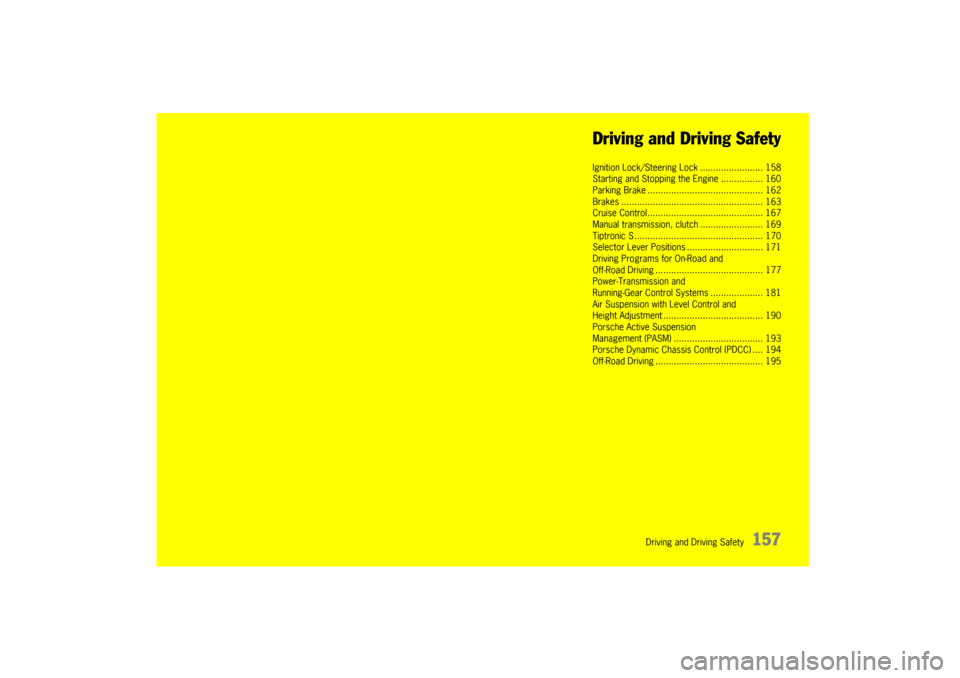
Driving and Driving Safety
157 Driving and Driving Safety
Ignition Lock/Steering Lock ........................ 158
Starting and Stopping the Engine ................ 160
Parking Brake ............................................ 162
Brakes ...................................................... 163
Cruise Control............................................ 167
Manual transmission, clutch ........................ 169
Tiptronic S ................................................. 170
Selector Lever Positions ............................. 171
Driving Programs for On-Road and
Off-Road Driving ......................................... 177
Power-Transmission and
Running-Gear Control Systems .................... 181
Air Suspension with Level Control and
Height Adjustment ...................................... 190
Porsche Active Suspension
Management (PASM) .................................. 193
Porsche Dynamic Chassis Control (PDCC) .... 194
Off-Road Driving ......................................... 195
10_Cayenne_21_KW17.book Seite 157 Donnerstag, 9. April 2009 3:33 15
Page 158 of 379
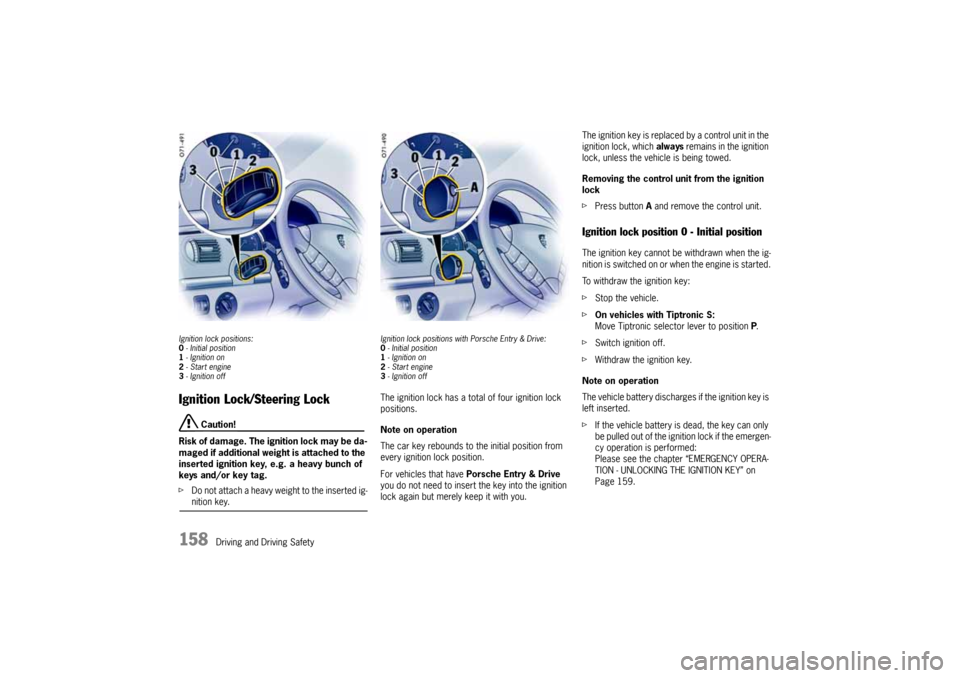
158
Driving and Driving Safety
Ignition lock positions:
0- Initial position
1- Ignition on
2-Start engine
3- Ignition offIgnition Lock/Steering Lock
Caution!
Risk of damage. The ignition lock may be da-
maged if additional weight is attached to the
inserted ignition key, e.g. a heavy bunch of
keys and/or key tag.
fDo not attach a heavy weight to the inserted ig-nition key.
Ignition lock positions with Porsche Entry & Drive:
0- Initial position
1- Ignition on
2-Start engine
3- Ignition offThe ignition lock has a total of four ignition lock
positions.
Note on operation
The car key rebounds to the initial position from
every ignition lock position.
For vehicles that have Porsche Entry & Drive
you do not need to insert the key into the ignition
lock again but merely keep it with you. The ignition key is replaced by a control unit in the
ignition lock, which always remains in the ignition
lock, unless the vehicle is being towed.
Removing the control unit from the ignition
lock
fPress button A and remove the control unit.
Ignition lock position 0 - Initial positionThe ignition key cannot be withdrawn when the ig-
nition is switched on or when the engine is started.
To withdraw the ignition key:
fStop the vehicle.
fOn vehicles with Tiptronic S:
Move Tiptronic selector lever to position P.
fSwitch ignition off.
fWithdraw the ignition key.
Note on operation
The vehicle battery discharges if the ignition key is
left inserted.
fIf the vehicle battery is dead, the key can only
be pulled out of the ignition lock if the emergen-
cy operation is performed:
Please see the chapter “EMERGENCY OPERA-
TION - UNLOCKING THE IGNITION KEY” on
Page 159.
10_Cayenne_21_KW17.book Seite 158 Donnerstag, 9. April 2009 3:33 15
Page 159 of 379
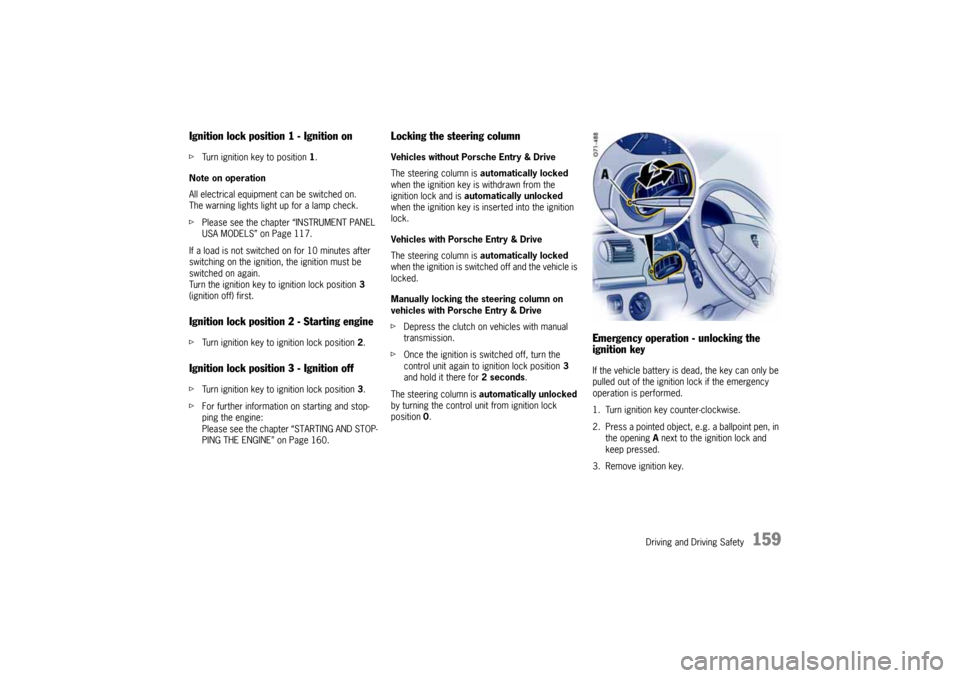
Driving and Driving Safety
159
Ignition lock position 1 - Ignition onfTurn ignition key to position 1.
Note on operation
All electrical equipment can be switched on.
The warning lights light up for a lamp check.
fPlease see the chapter “INSTRUMENT PANEL
USA MODELS” on Page 117.
If a load is not switched on for 10 minutes after
switching on the ignition, the ignition must be
switched on again.
Turn the ignition key to ignition lock position 3
(ignition off) first.Ignition lock position 2 - Starting enginefTurn ignition key to ignition lock position 2.Ignition lock position 3 - Ignition offfTurn ignition key to ignition lock position 3.
fFor further information on starting and stop-
ping the engine:
Please see the chapter “STARTING AND STOP-
PING THE ENGINE” on Page 160.
Locking the steering column Vehicles without Porsche Entry & Drive
The steering column is automatically locked
when the ignition key is withdrawn from the
ignition lock and is automatically unlocked
when the ignition key is inserted into the ignition
lock.
Vehicles with Porsche Entry & Drive
The steering column is automatically locked
when the ignition is switched off and the vehicle is
locked.
Manually locking the steering column on
vehicles with Porsche Entry & Drive
fDepress the clutch on vehicles with manual
transmission.
fOnce the ignition is switched off, turn the
control unit again to ignition lock position 3
and hold it there for 2seconds.
The steering column is automatically unlocked
by turning the control unit from ignition lock
position 0.
Emergency operation - unlocking the
ignition keyIf the vehicle battery is dead, the key can only be
pulled out of the ignition lock if the emergency
operation is performed.
1. Turn ignition key counter-clockwise.
2. Press a pointed object, e.g. a ballpoint pen, in
the opening A next to the ignition lock and
keep pressed.
3. Remove ignition key.
10_Cayenne_21_KW17.book Seite 159 Donnerstag, 9. April 2009 3:33 15
Page 160 of 379

160
Driving and Driving Safety
Starting and Stopping the EnginefPlease see the chapter “IMMOBILIZER” on
Page 248.
fPlease see the chapter “EMISSION CONTROL
SYSTEM” on Page 263.
Danger!
Risk of poisoning. Exhaust gas contains
colorless and odorless carbon monoxide
(CO), which is toxic even in low concentra-
tion. Carbon monoxide can cause uncon-
sciousness and even death if inhaled.
fNever start or let the engine run in an en-
closed, unventilated area. It is not recommen-
ded to sit in your car for prolonged periods
with the engine on and the car not moving.
An unattended vehicle with a running engine
is potentially hazardous. If warning lights
should come on to indicate improper opera-
tion, they would go unnoticed.
fNever leave the engine idling unattended.
Danger of fire.
fDo not drive or park your car where combus-
tible materials, such as dry grass or leaves,
can come into contact with the hot exhaust
system.
fIf your car catches on fire for any reason, call
the fire department. Do not endanger your life by attempting to put out the fire.
Starting vehiclefOperate footbrake.
fFully depress and hold the clutch pedal. Put the
gearshift lever in neutral or on vehicles with
Tiptronic S:
move the Tiptronic selector lever to position P
or N.
fDo not press the accelerator pedal. The engine
control module will provide the correct starting
mixture.
fTurn ignition key to ignition lock position 2.
fDo not operate the starter longer than approx.
10 seconds. If necessary, repeat the starting
procedure after a pause of approx.
10 seconds. Turn the ignition key back to
ignition lock position 3 first.
Notes on operation
The first operation of the starter is ended auto-
matically when the engine starts.
If the engine does not start, subsequent starter
operations will not be ended automatically.
When the engine ist started, the warning lights
must go out.fDo not warm up the engine when stationary.
Drive off immediately.
Avoid high revolutions and full throttle until the
engine has reached operating temperature.
fIf battery output is insufficient, jump leads can
be used to start the engine.
Please see the chapter “EMERGENCY
STARTING WITH JUMPER CABLES” on
Page 323.
Note on operation
To ensure a good charge condition for the battery
and thus its ability to start the engine, all electrical
accessories which are not required should be
switched off when the ignition is switched on and
when engine revolutions are low (in stop and go
traffic).
10_Cayenne_21_KW17.book Seite 160 Donnerstag, 9. April 2009 3:33 15
Page 161 of 379

Driving and Driving Safety
161
StoppingfWithdraw the ignition key only when the vehicle
is stationary, otherwise the steering lock
engages and the vehicle cannot be steered.
fOnly switch the ignition off when the vehicle
comes to a stop, as there is no steering assis-
tance and brake boost when the engine is
switched off.
fWhen leaving the vehicle, always remove the
ignition key and engage the parking brake.
Engage the parking lock on vehicles with
Tiptronic S (Tiptronic selector lever position
P). Engage first gear or reverse gear on vehic-
les with manual transmission.
The control unit always remains in the ignition
lock in vehicles that have Porsche Entry &
Drive.
Note on operation
The vehicle battery discharges if the ignition key is
left inserted.
Warning!
Danger of injury. Hot engine compartment
components can burn skin on contact.
fBefore working on any part in the engine
compartment, turn the engine off and let it cool
down sufficiently.
Risk of burn injury when standing near or co-
ming into contact with the exhaust pipe.
The exhaust pipe is hot when the vehicle is running
and remains hot for some time after the vehicle is
turned off.
fTo prevent injury, make a point of noting where
your vehicle’s exhaust pipe is, avoid placing
your legs near the exhaust pipe when loading
and unloading cargo in the rear, and closely
supervise children around the vehicle during
time when the exhaust pipe could be hot. A hot exhaust pipe can cause serious burns.Radiator fans
The radiator and radiator fans are in the front of
the car.
Warning!
Danger of injury. After the ignition is
switched off, the engine compartment and
coolant temperatures are monitored for
approx. 30 minutes. During this period, and
depending on temperature, the radiator fan
may continue to run or start to run.
fCarry out work in these areas only with the engine off and exercise extreme caution.
10_Cayenne_21_KW17.book Seite 161 Donnerstag, 9. April 2009 3:33 15
Page 165 of 379

Driving and Driving Safety
165
Brake boosterThe brake booster assists braking only when
the engine is running.
When the car is moving while the engine is not
running, or if the brake booster is defective, more
pressure on the brake pedal is required to bring
the car to a stop.
Moisture, road salt or grit on brakes affects
braking.
Brakes will dry after a few cautious brake applica-
tions.
Warning!
Risk of an accident, resulting in serious per-
sonal injury or death.
Driving through water may reduce the trac-
tion. Moisture on brakes from road water, car
wash, or a coating of road salt or grit may
affect braking efficiency.
fCautiously apply brakes to test brakes after exposure to road water, etc.
Brake wearYour car has excellent brakes, but they are still
subject to wear. The rate at which they wear
depends on how the brakes are used.
fHave the brake system inspected at the inter-
vals recommended in your Maintenance Book-
let.
Brake system warning light
You can check the functionality of the brake sys-
tem warning light by switching the ignition to the
“On” position and verifying that the warning light
illuminates.
A warning message will be displayed on the multi-
purpose display of the instrument panel if the
brake pads are worn, excessively.
fDo not continue to operate the vehicle.
Have your authorized Porsche dealer inspect
or replace the brake pads.
fPlease see the chapter “OVERVIEW OF
WARNING MESSAGES” on Page 149.
Brake pads and brake discsWear on the brake pads and brake discs depends
to a great extent on the driving style and the con-
ditions of use and therefore cannot be expressed
in actual miles on the road.
The high-performance brake system is designed
for optimal braking effect at all speeds and tem-
peratures.
Certain speeds, braking forces and ambient
conditions (such as temperature and humidity)
therefore might cause the brakes to squeal.
Brake wear warning message
10_Cayenne_21_KW17.book Seite 165 Donnerstag, 9. April 2009 3:33 15
Page 166 of 379

166
Driving and Driving Safety New brake pads or linings
New brake pads have to be “broken in”, and there-
fore only attain optimal friction when the car has
covered several hundred miles or km.
The slightly reduced braking ability must be com-
pensated for by pressing the brake pedal harder.
This also applies whenever the brake pads and
brake discs are replaced.
Warning!
fDo not obstruct the pedal travel with floor mats
or other objects.
The brake booster is ready for operation only
while the engine is running.
If the engine is switched off or there is a defect in
the brake booster, much greater force has to be
applied to the pedal when braking.
fPlease see the chapter “TOWING” on
Page 342.
In heavy rain, while driving through water or after
leaving a car wash, the braking action may be
delayed and increased pressure may be required.
fFor this reason, keep further back from the ve-
hicle in front and “dry” the brakes by applying
them at intervals. Make sure that following traf-
fic is not affected.
After a long drive over salted or sanded roads, a
coating may form on the brake discs and pads
that significantly reduces friction and thus braking
action.fEven though the brake discs consist of alloyed
grey cast iron, they will unavoidably start to
corrode if your car is parked for an extended
period. The brakes will tend to “rub” as a
result.
The nature, extent and effects of corrosion
depend on the amount of time the vehicle was
parked, whether road salt or grit was spread
and whether grease-dissolving agents were
used in car washes (not on vehicles with
Porsche Ceramic Composite Brake).
To prevent corrosion of the brake discs, “brake
them dry” before parking the car (not on
vehicles with Porsche Ceramic Composite
Brake).
If the braking comfort is noticeably impaired,
we recommend having the brake system
checked by experts at an authorized Porsche
dealer.
fTo relieve the braking system on downhill
stretches, change down to a lower gear in
enough time to obtain engine braking.
If engine braking is insufficient on steep
stretches, operate the footbrake at intervals.
Continuous braking overheats the brakes and
reduces the braking effect.
fPlease see the chapter “BRAKE-FLUID LEVEL”
on Page 257.
10_Cayenne_21_KW17.book Seite 166 Donnerstag, 9. April 2009 3:33 15
Page 168 of 379

168
Driving and Driving Safety
DeceleratingOption 1
fPush operating lever down into position 4 until
the desired speed is reached.
The speed reached is maintained and stored
when the operating lever is released.
Option 2
fPush operating lever slightly downwards into
position 4 (a maximum of 10 times).
The speed is reduced by 1 mph (2 km/h), each
time the lever is pushed downwards.
Interrupting cruise control operationThe speed driven before the interruption remains
stored in the memory and can be reactivated by
operating the operating lever. Please see the
chapter “RESUMING THE STORED SPEED” on
Page 168.
fPush the operating lever forward to position 2
(it doesn’t engage) or
fOperate brake or clutch pedal or, on vehicles
with Tiptronic S, select position N.
fPlease see the chapter “TIPTRONIC S” on
Page 170.
Cruise control operation is interrupted
automatically:
– If the set vehicle speed is exceeded by more
than approx. 16 mph (25 km/h) for longer than
20 seconds.
– If the actual vehicle speed falls by approx.
6 mph (10 km/h) below the set vehicle speed
for longer than 5 seconds (e.g. upward
slopes).
– If Porsche Stability Management (PSM)
intervenes for longer than 0.2 seconds.
– If Low Range is switched on.
Resuming the stored speedfPull back the operating lever to position 1.
Note on operation
The stored speed should only be recalled when
traffic conditions and the road surface so permit.Switching cruise control readiness offfPush forward the operating lever to position 2
until it clicks audibly into place.
The memory is cleared and the green
readiness light goes out.
When the vehicle is parked and the ignition
switched off, the memory is cleared.
Tip on driving
On upward or downward slopes, the set speed
cannot always be maintained by cruise control.
fTo obtain sufficient engine braking or a better
engine-speed range, therefore, you have to
change down to a lower gear.
10_Cayenne_21_KW17.book Seite 168 Donnerstag, 9. April 2009 3:33 15
Page 169 of 379
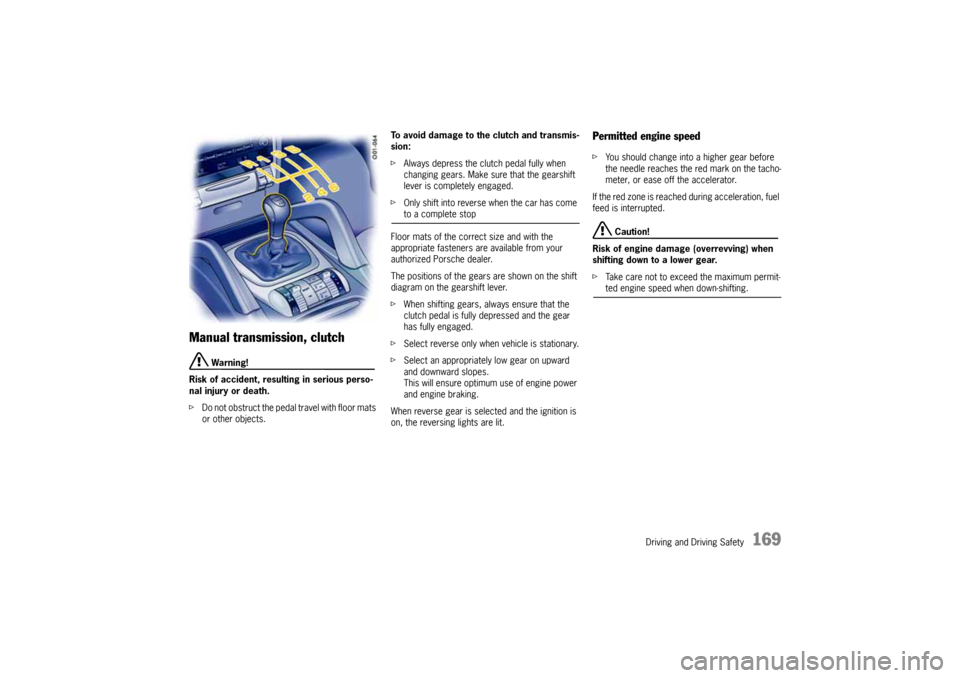
Driving and Driving Safety
169
Manual transmission, clutch
Warning!
Risk of accident, resulting in serious perso-
nal injury or death.
fDo not obstruct the pedal travel with floor mats
or other objects.To avoid damage to the clutch and transmis-
sion:
fAlways depress the clutch pedal fully when
changing gears. Make sure that the gearshift
lever is completely engaged.
fOnly shift into reverse when the car has come
to a complete stop
Floor mats of the correct size and with the
appropriate fasteners are available from your
authorized Porsche dealer.
The positions of the gears are shown on the shift
diagram on the gearshift lever.
fWhen shifting gears, always ensure that the
clutch pedal is fully depressed and the gear
has fully engaged.
fSelect reverse only when vehicle is stationary.
fSelect an appropriately low gear on upward
and downward slopes.
This will ensure optimum use of engine power
and engine braking.
When reverse gear is selected and the ignition is
on, the reversing lights are lit.
Permitted engine speedfYou should change into a higher gear before
the needle reaches the red mark on the tacho-
meter, or ease off the accelerator.
If the red zone is reached during acceleration, fuel
feed is interrupted.
Caution!
Risk of engine damage (overrevving) when
shifting down to a lower gear.
fTake care not to exceed the maximum permit-ted engine speed when down-shifting.
10_Cayenne_21_KW17.book Seite 169 Donnerstag, 9. April 2009 3:33 15